The History of Slavery in Northwest Coast Communities: Causes and End
VerifiedAdded on 2023/01/16
|14
|3825
|62
Essay
AI Summary
This essay provides a comprehensive overview of slavery among the people of the Northwest Coast, drawing on the writings and journals of early travelers, explorers, missionaries, and traders. It explores the reasons behind the prevalence of slavery in the region, including the demand for labor, the impact of European influence, and religious factors. The essay also examines the factors that led to the eventual end of slavery, such as changing public opinion, the abolitionist movement, and the decline in the economic significance of slavery. Furthermore, the essay highlights the resistance of the native people and the role of political and social changes in ending slavery. It analyzes the role of various communities, European powers, and internal conflicts in shaping the history of slavery in the Northwest Coast. The essay concludes by emphasizing the complex and multifaceted nature of this historical phenomenon.
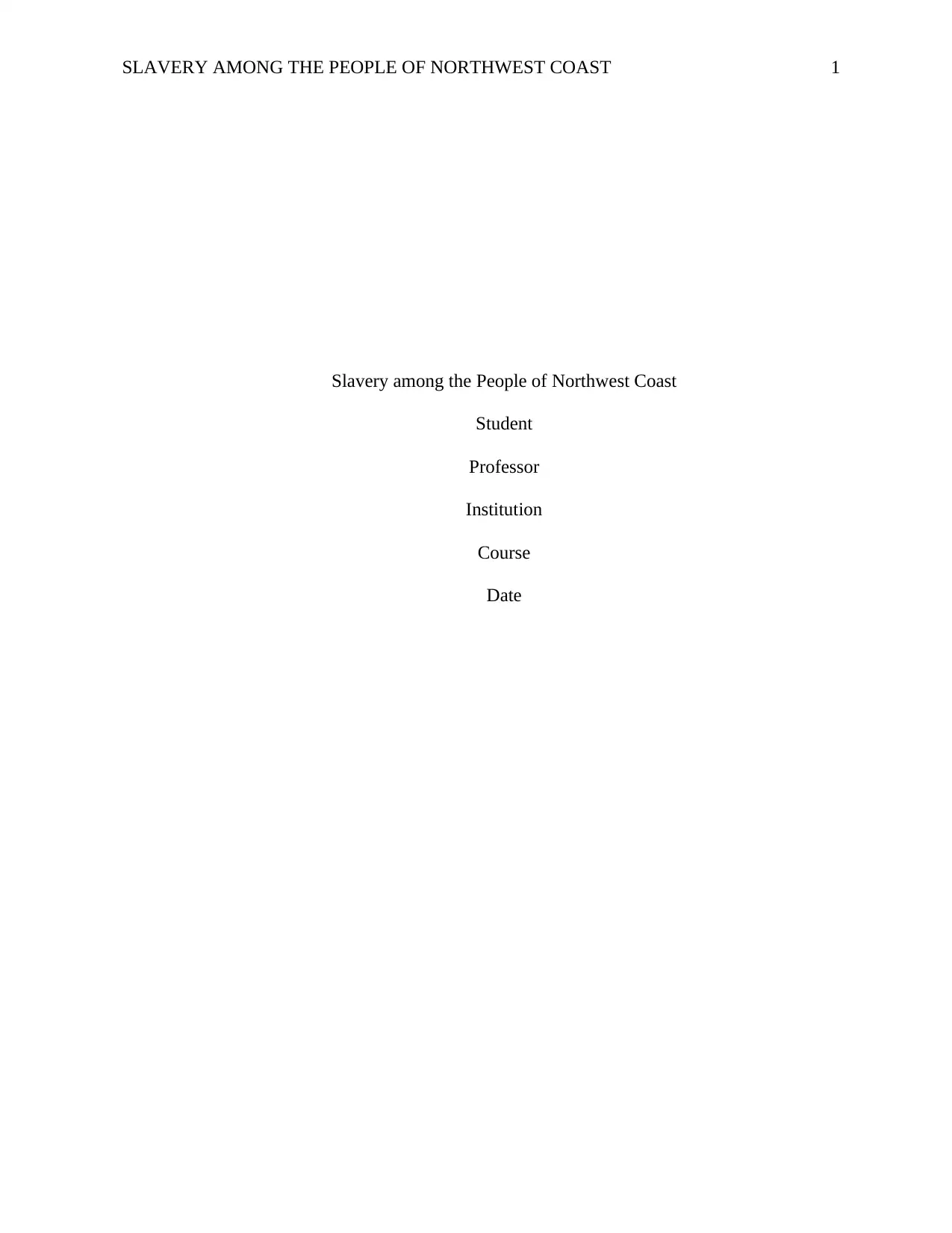
SLAVERY AMONG THE PEOPLE OF NORTHWEST COAST 1
Slavery among the People of Northwest Coast
Student
Professor
Institution
Course
Date
Slavery among the People of Northwest Coast
Student
Professor
Institution
Course
Date
Paraphrase This Document
Need a fresh take? Get an instant paraphrase of this document with our AI Paraphraser
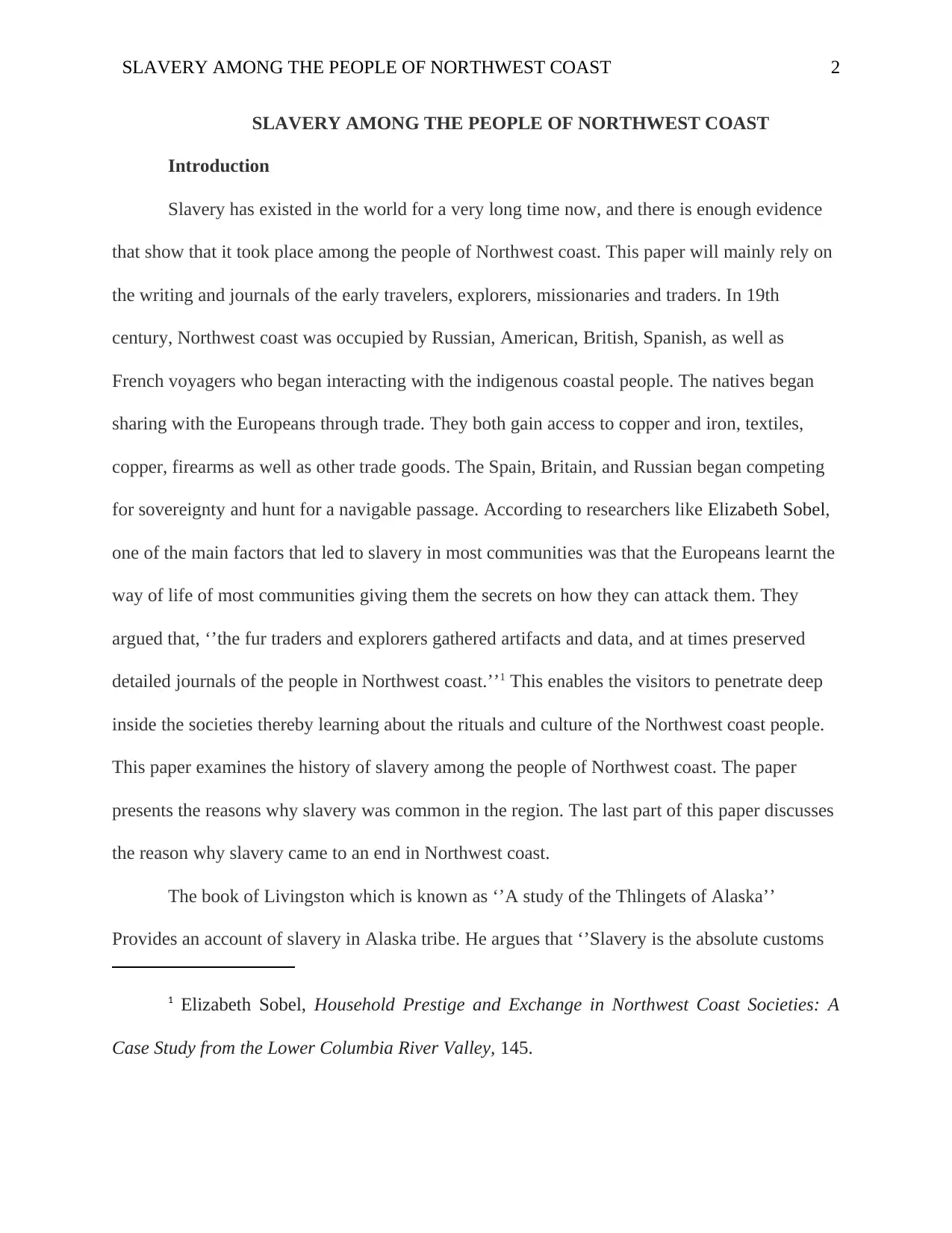
SLAVERY AMONG THE PEOPLE OF NORTHWEST COAST 2
SLAVERY AMONG THE PEOPLE OF NORTHWEST COAST
Introduction
Slavery has existed in the world for a very long time now, and there is enough evidence
that show that it took place among the people of Northwest coast. This paper will mainly rely on
the writing and journals of the early travelers, explorers, missionaries and traders. In 19th
century, Northwest coast was occupied by Russian, American, British, Spanish, as well as
French voyagers who began interacting with the indigenous coastal people. The natives began
sharing with the Europeans through trade. They both gain access to copper and iron, textiles,
copper, firearms as well as other trade goods. The Spain, Britain, and Russian began competing
for sovereignty and hunt for a navigable passage. According to researchers like Elizabeth Sobel,
one of the main factors that led to slavery in most communities was that the Europeans learnt the
way of life of most communities giving them the secrets on how they can attack them. They
argued that, ‘’the fur traders and explorers gathered artifacts and data, and at times preserved
detailed journals of the people in Northwest coast.’’1 This enables the visitors to penetrate deep
inside the societies thereby learning about the rituals and culture of the Northwest coast people.
This paper examines the history of slavery among the people of Northwest coast. The paper
presents the reasons why slavery was common in the region. The last part of this paper discusses
the reason why slavery came to an end in Northwest coast.
The book of Livingston which is known as ‘’A study of the Thlingets of Alaska’’
Provides an account of slavery in Alaska tribe. He argues that ‘’Slavery is the absolute customs
1 Elizabeth Sobel, Household Prestige and Exchange in Northwest Coast Societies: A
Case Study from the Lower Columbia River Valley, 145.
SLAVERY AMONG THE PEOPLE OF NORTHWEST COAST
Introduction
Slavery has existed in the world for a very long time now, and there is enough evidence
that show that it took place among the people of Northwest coast. This paper will mainly rely on
the writing and journals of the early travelers, explorers, missionaries and traders. In 19th
century, Northwest coast was occupied by Russian, American, British, Spanish, as well as
French voyagers who began interacting with the indigenous coastal people. The natives began
sharing with the Europeans through trade. They both gain access to copper and iron, textiles,
copper, firearms as well as other trade goods. The Spain, Britain, and Russian began competing
for sovereignty and hunt for a navigable passage. According to researchers like Elizabeth Sobel,
one of the main factors that led to slavery in most communities was that the Europeans learnt the
way of life of most communities giving them the secrets on how they can attack them. They
argued that, ‘’the fur traders and explorers gathered artifacts and data, and at times preserved
detailed journals of the people in Northwest coast.’’1 This enables the visitors to penetrate deep
inside the societies thereby learning about the rituals and culture of the Northwest coast people.
This paper examines the history of slavery among the people of Northwest coast. The paper
presents the reasons why slavery was common in the region. The last part of this paper discusses
the reason why slavery came to an end in Northwest coast.
The book of Livingston which is known as ‘’A study of the Thlingets of Alaska’’
Provides an account of slavery in Alaska tribe. He argues that ‘’Slavery is the absolute customs
1 Elizabeth Sobel, Household Prestige and Exchange in Northwest Coast Societies: A
Case Study from the Lower Columbia River Valley, 145.
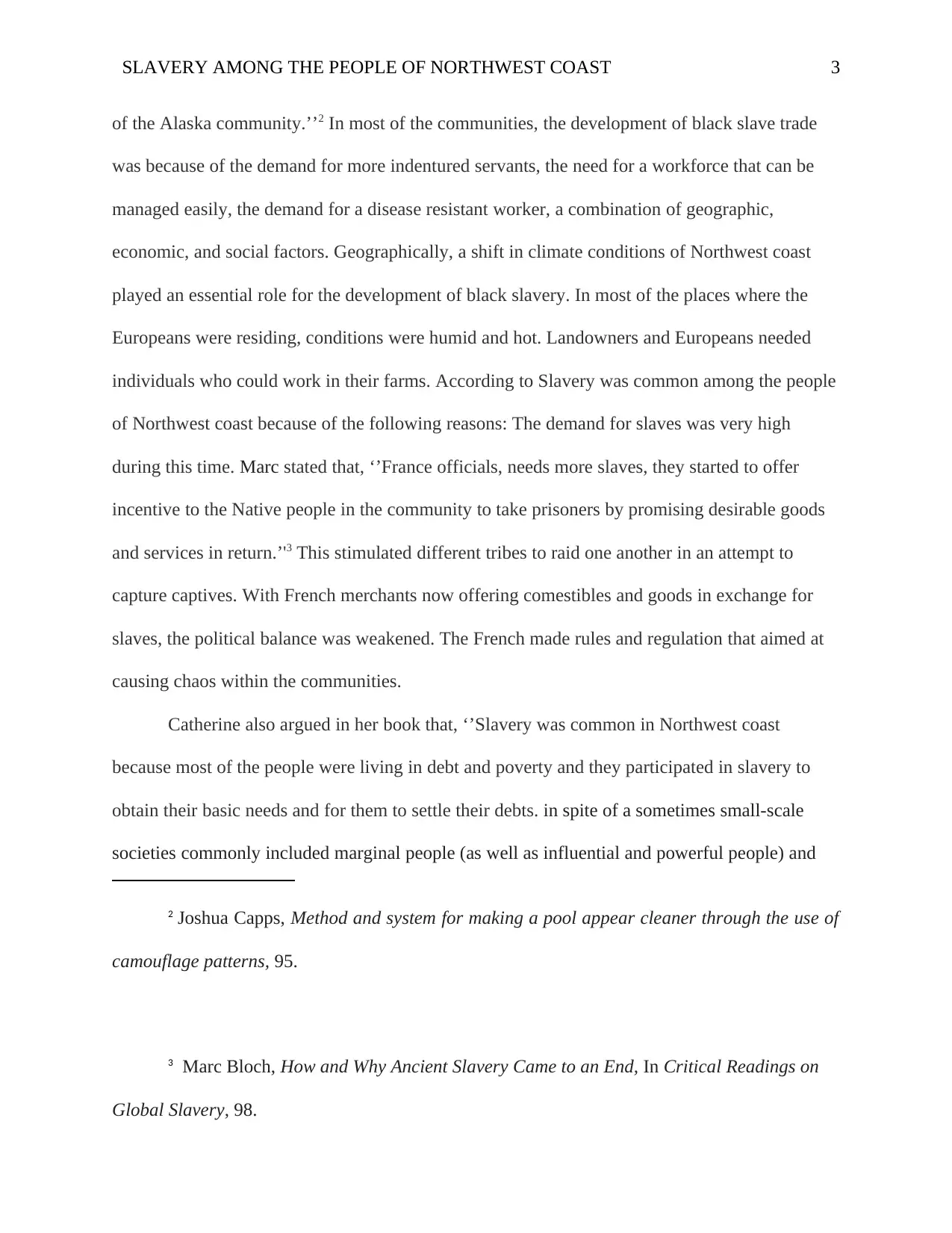
SLAVERY AMONG THE PEOPLE OF NORTHWEST COAST 3
of the Alaska community.’’2 In most of the communities, the development of black slave trade
was because of the demand for more indentured servants, the need for a workforce that can be
managed easily, the demand for a disease resistant worker, a combination of geographic,
economic, and social factors. Geographically, a shift in climate conditions of Northwest coast
played an essential role for the development of black slavery. In most of the places where the
Europeans were residing, conditions were humid and hot. Landowners and Europeans needed
individuals who could work in their farms. According to Slavery was common among the people
of Northwest coast because of the following reasons: The demand for slaves was very high
during this time. Marc stated that, ‘’France officials, needs more slaves, they started to offer
incentive to the Native people in the community to take prisoners by promising desirable goods
and services in return.’'3 This stimulated different tribes to raid one another in an attempt to
capture captives. With French merchants now offering comestibles and goods in exchange for
slaves, the political balance was weakened. The French made rules and regulation that aimed at
causing chaos within the communities.
Catherine also argued in her book that, ‘’Slavery was common in Northwest coast
because most of the people were living in debt and poverty and they participated in slavery to
obtain their basic needs and for them to settle their debts. in spite of a sometimes small-scale
societies commonly included marginal people (as well as influential and powerful people) and
2 Joshua Capps, Method and system for making a pool appear cleaner through the use of
camouflage patterns, 95.
3 Marc Bloch, How and Why Ancient Slavery Came to an End, In Critical Readings on
Global Slavery, 98.
of the Alaska community.’’2 In most of the communities, the development of black slave trade
was because of the demand for more indentured servants, the need for a workforce that can be
managed easily, the demand for a disease resistant worker, a combination of geographic,
economic, and social factors. Geographically, a shift in climate conditions of Northwest coast
played an essential role for the development of black slavery. In most of the places where the
Europeans were residing, conditions were humid and hot. Landowners and Europeans needed
individuals who could work in their farms. According to Slavery was common among the people
of Northwest coast because of the following reasons: The demand for slaves was very high
during this time. Marc stated that, ‘’France officials, needs more slaves, they started to offer
incentive to the Native people in the community to take prisoners by promising desirable goods
and services in return.’'3 This stimulated different tribes to raid one another in an attempt to
capture captives. With French merchants now offering comestibles and goods in exchange for
slaves, the political balance was weakened. The French made rules and regulation that aimed at
causing chaos within the communities.
Catherine also argued in her book that, ‘’Slavery was common in Northwest coast
because most of the people were living in debt and poverty and they participated in slavery to
obtain their basic needs and for them to settle their debts. in spite of a sometimes small-scale
societies commonly included marginal people (as well as influential and powerful people) and
2 Joshua Capps, Method and system for making a pool appear cleaner through the use of
camouflage patterns, 95.
3 Marc Bloch, How and Why Ancient Slavery Came to an End, In Critical Readings on
Global Slavery, 98.
⊘ This is a preview!⊘
Do you want full access?
Subscribe today to unlock all pages.

Trusted by 1+ million students worldwide
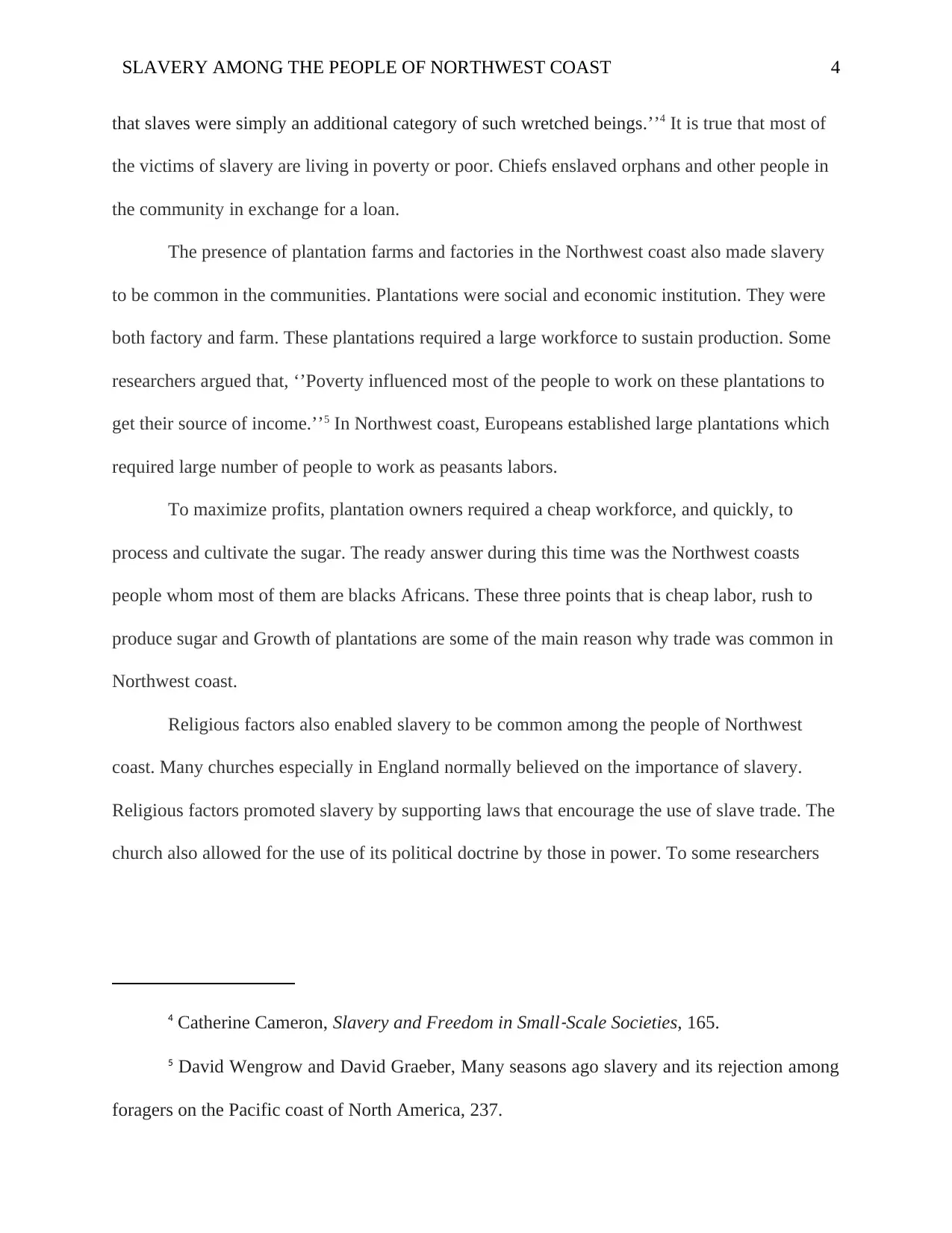
SLAVERY AMONG THE PEOPLE OF NORTHWEST COAST 4
that slaves were simply an additional category of such wretched beings.’’4 It is true that most of
the victims of slavery are living in poverty or poor. Chiefs enslaved orphans and other people in
the community in exchange for a loan.
The presence of plantation farms and factories in the Northwest coast also made slavery
to be common in the communities. Plantations were social and economic institution. They were
both factory and farm. These plantations required a large workforce to sustain production. Some
researchers argued that, ‘’Poverty influenced most of the people to work on these plantations to
get their source of income.’’5 In Northwest coast, Europeans established large plantations which
required large number of people to work as peasants labors.
To maximize profits, plantation owners required a cheap workforce, and quickly, to
process and cultivate the sugar. The ready answer during this time was the Northwest coasts
people whom most of them are blacks Africans. These three points that is cheap labor, rush to
produce sugar and Growth of plantations are some of the main reason why trade was common in
Northwest coast.
Religious factors also enabled slavery to be common among the people of Northwest
coast. Many churches especially in England normally believed on the importance of slavery.
Religious factors promoted slavery by supporting laws that encourage the use of slave trade. The
church also allowed for the use of its political doctrine by those in power. To some researchers
4 Catherine Cameron, Slavery and Freedom in Small
‐Scale Societies, 165.
5 David Wengrow and David Graeber, Many seasons ago slavery and its rejection among
foragers on the Pacific coast of North America, 237.
that slaves were simply an additional category of such wretched beings.’’4 It is true that most of
the victims of slavery are living in poverty or poor. Chiefs enslaved orphans and other people in
the community in exchange for a loan.
The presence of plantation farms and factories in the Northwest coast also made slavery
to be common in the communities. Plantations were social and economic institution. They were
both factory and farm. These plantations required a large workforce to sustain production. Some
researchers argued that, ‘’Poverty influenced most of the people to work on these plantations to
get their source of income.’’5 In Northwest coast, Europeans established large plantations which
required large number of people to work as peasants labors.
To maximize profits, plantation owners required a cheap workforce, and quickly, to
process and cultivate the sugar. The ready answer during this time was the Northwest coasts
people whom most of them are blacks Africans. These three points that is cheap labor, rush to
produce sugar and Growth of plantations are some of the main reason why trade was common in
Northwest coast.
Religious factors also enabled slavery to be common among the people of Northwest
coast. Many churches especially in England normally believed on the importance of slavery.
Religious factors promoted slavery by supporting laws that encourage the use of slave trade. The
church also allowed for the use of its political doctrine by those in power. To some researchers
4 Catherine Cameron, Slavery and Freedom in Small
‐Scale Societies, 165.
5 David Wengrow and David Graeber, Many seasons ago slavery and its rejection among
foragers on the Pacific coast of North America, 237.
Paraphrase This Document
Need a fresh take? Get an instant paraphrase of this document with our AI Paraphraser
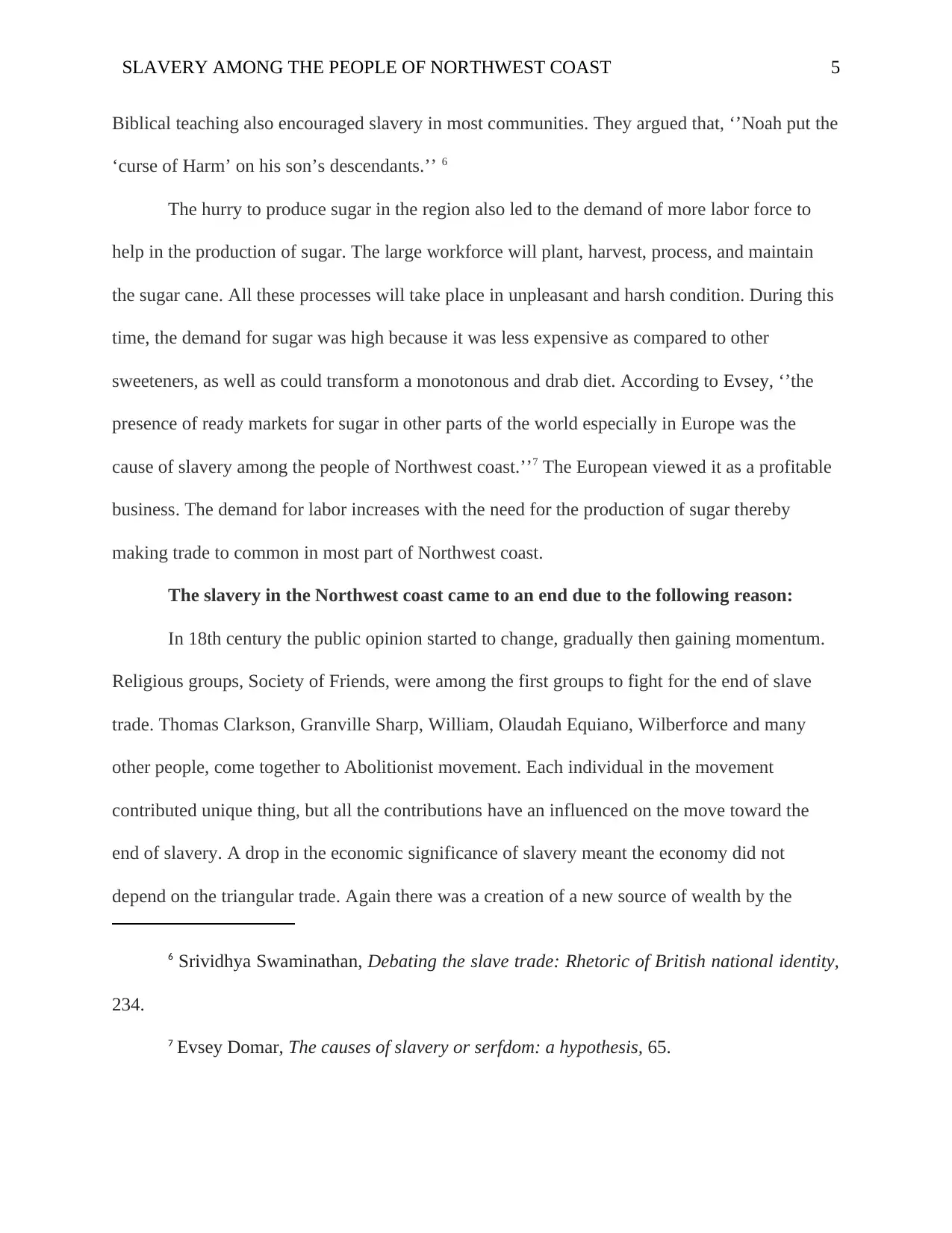
SLAVERY AMONG THE PEOPLE OF NORTHWEST COAST 5
Biblical teaching also encouraged slavery in most communities. They argued that, ‘’Noah put the
‘curse of Harm’ on his son’s descendants.’’ 6
The hurry to produce sugar in the region also led to the demand of more labor force to
help in the production of sugar. The large workforce will plant, harvest, process, and maintain
the sugar cane. All these processes will take place in unpleasant and harsh condition. During this
time, the demand for sugar was high because it was less expensive as compared to other
sweeteners, as well as could transform a monotonous and drab diet. According to Evsey, ‘’the
presence of ready markets for sugar in other parts of the world especially in Europe was the
cause of slavery among the people of Northwest coast.’’7 The European viewed it as a profitable
business. The demand for labor increases with the need for the production of sugar thereby
making trade to common in most part of Northwest coast.
The slavery in the Northwest coast came to an end due to the following reason:
In 18th century the public opinion started to change, gradually then gaining momentum.
Religious groups, Society of Friends, were among the first groups to fight for the end of slave
trade. Thomas Clarkson, Granville Sharp, William, Olaudah Equiano, Wilberforce and many
other people, come together to Abolitionist movement. Each individual in the movement
contributed unique thing, but all the contributions have an influenced on the move toward the
end of slavery. A drop in the economic significance of slavery meant the economy did not
depend on the triangular trade. Again there was a creation of a new source of wealth by the
6 Srividhya Swaminathan, Debating the slave trade: Rhetoric of British national identity,
234.
7 Evsey Domar, The causes of slavery or serfdom: a hypothesis, 65.
Biblical teaching also encouraged slavery in most communities. They argued that, ‘’Noah put the
‘curse of Harm’ on his son’s descendants.’’ 6
The hurry to produce sugar in the region also led to the demand of more labor force to
help in the production of sugar. The large workforce will plant, harvest, process, and maintain
the sugar cane. All these processes will take place in unpleasant and harsh condition. During this
time, the demand for sugar was high because it was less expensive as compared to other
sweeteners, as well as could transform a monotonous and drab diet. According to Evsey, ‘’the
presence of ready markets for sugar in other parts of the world especially in Europe was the
cause of slavery among the people of Northwest coast.’’7 The European viewed it as a profitable
business. The demand for labor increases with the need for the production of sugar thereby
making trade to common in most part of Northwest coast.
The slavery in the Northwest coast came to an end due to the following reason:
In 18th century the public opinion started to change, gradually then gaining momentum.
Religious groups, Society of Friends, were among the first groups to fight for the end of slave
trade. Thomas Clarkson, Granville Sharp, William, Olaudah Equiano, Wilberforce and many
other people, come together to Abolitionist movement. Each individual in the movement
contributed unique thing, but all the contributions have an influenced on the move toward the
end of slavery. A drop in the economic significance of slavery meant the economy did not
depend on the triangular trade. Again there was a creation of a new source of wealth by the
6 Srividhya Swaminathan, Debating the slave trade: Rhetoric of British national identity,
234.
7 Evsey Domar, The causes of slavery or serfdom: a hypothesis, 65.
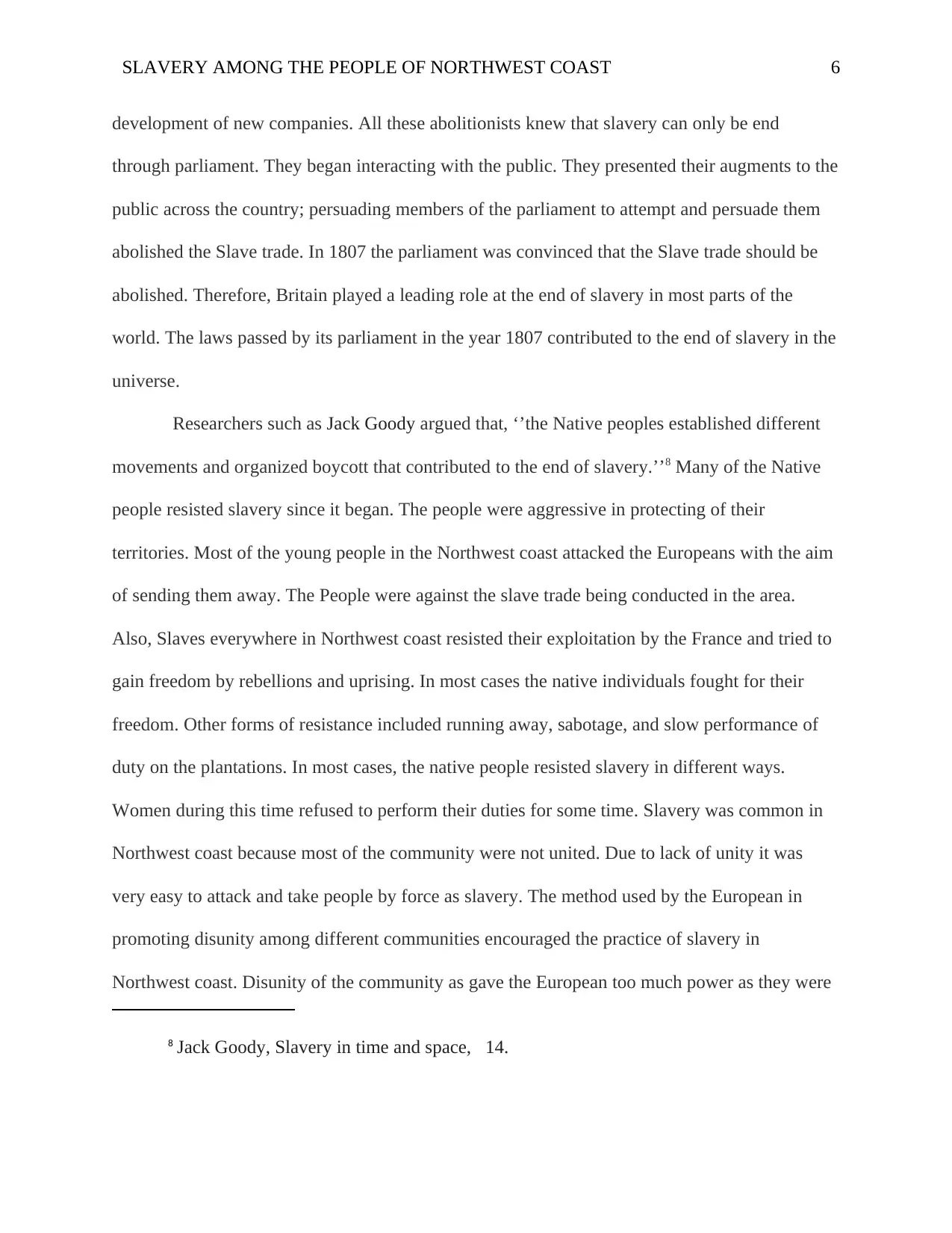
SLAVERY AMONG THE PEOPLE OF NORTHWEST COAST 6
development of new companies. All these abolitionists knew that slavery can only be end
through parliament. They began interacting with the public. They presented their augments to the
public across the country; persuading members of the parliament to attempt and persuade them
abolished the Slave trade. In 1807 the parliament was convinced that the Slave trade should be
abolished. Therefore, Britain played a leading role at the end of slavery in most parts of the
world. The laws passed by its parliament in the year 1807 contributed to the end of slavery in the
universe.
Researchers such as Jack Goody argued that, ‘’the Native peoples established different
movements and organized boycott that contributed to the end of slavery.’’8 Many of the Native
people resisted slavery since it began. The people were aggressive in protecting of their
territories. Most of the young people in the Northwest coast attacked the Europeans with the aim
of sending them away. The People were against the slave trade being conducted in the area.
Also, Slaves everywhere in Northwest coast resisted their exploitation by the France and tried to
gain freedom by rebellions and uprising. In most cases the native individuals fought for their
freedom. Other forms of resistance included running away, sabotage, and slow performance of
duty on the plantations. In most cases, the native people resisted slavery in different ways.
Women during this time refused to perform their duties for some time. Slavery was common in
Northwest coast because most of the community were not united. Due to lack of unity it was
very easy to attack and take people by force as slavery. The method used by the European in
promoting disunity among different communities encouraged the practice of slavery in
Northwest coast. Disunity of the community as gave the European too much power as they were
8 Jack Goody, Slavery in time and space, 14.
development of new companies. All these abolitionists knew that slavery can only be end
through parliament. They began interacting with the public. They presented their augments to the
public across the country; persuading members of the parliament to attempt and persuade them
abolished the Slave trade. In 1807 the parliament was convinced that the Slave trade should be
abolished. Therefore, Britain played a leading role at the end of slavery in most parts of the
world. The laws passed by its parliament in the year 1807 contributed to the end of slavery in the
universe.
Researchers such as Jack Goody argued that, ‘’the Native peoples established different
movements and organized boycott that contributed to the end of slavery.’’8 Many of the Native
people resisted slavery since it began. The people were aggressive in protecting of their
territories. Most of the young people in the Northwest coast attacked the Europeans with the aim
of sending them away. The People were against the slave trade being conducted in the area.
Also, Slaves everywhere in Northwest coast resisted their exploitation by the France and tried to
gain freedom by rebellions and uprising. In most cases the native individuals fought for their
freedom. Other forms of resistance included running away, sabotage, and slow performance of
duty on the plantations. In most cases, the native people resisted slavery in different ways.
Women during this time refused to perform their duties for some time. Slavery was common in
Northwest coast because most of the community were not united. Due to lack of unity it was
very easy to attack and take people by force as slavery. The method used by the European in
promoting disunity among different communities encouraged the practice of slavery in
Northwest coast. Disunity of the community as gave the European too much power as they were
8 Jack Goody, Slavery in time and space, 14.
⊘ This is a preview!⊘
Do you want full access?
Subscribe today to unlock all pages.

Trusted by 1+ million students worldwide
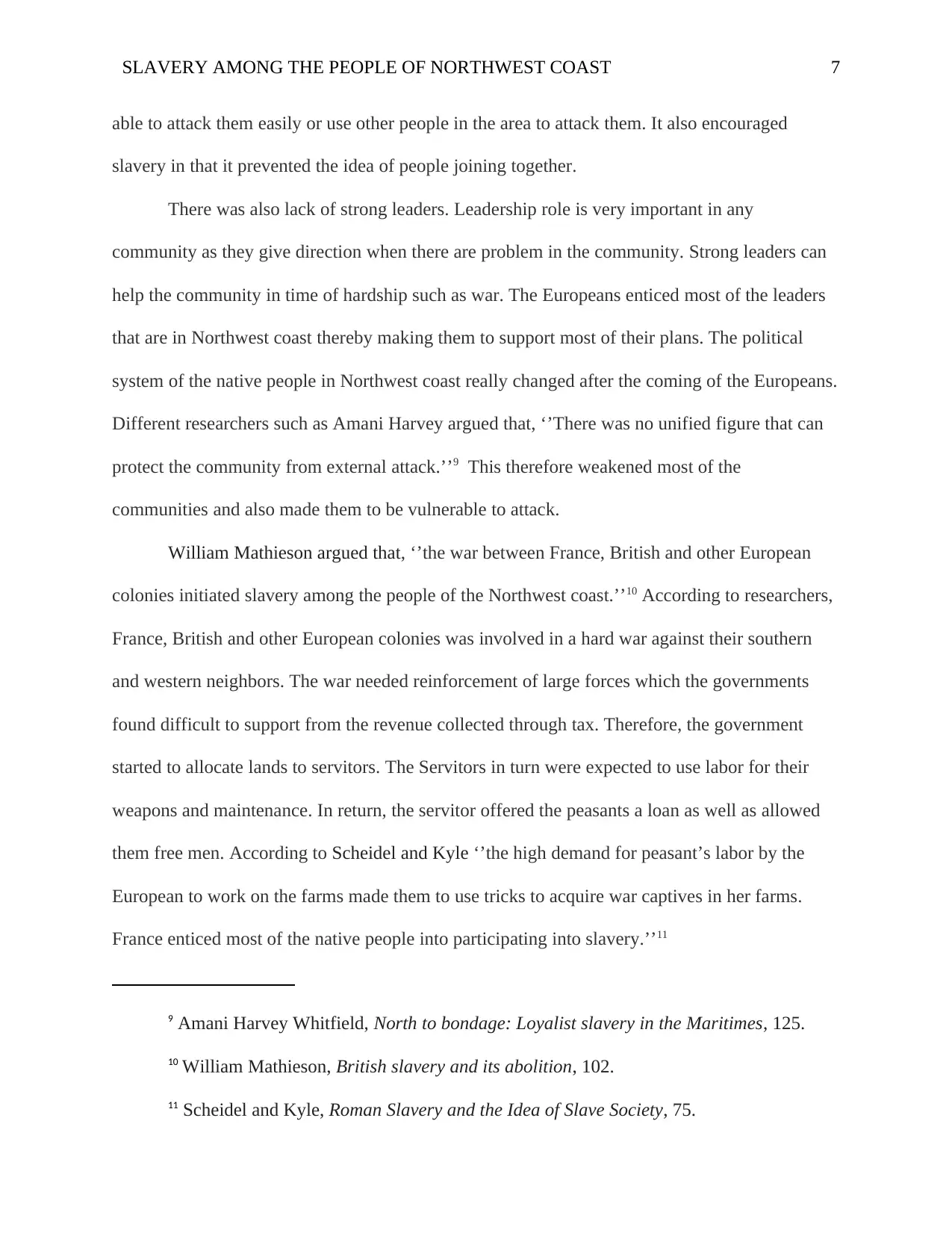
SLAVERY AMONG THE PEOPLE OF NORTHWEST COAST 7
able to attack them easily or use other people in the area to attack them. It also encouraged
slavery in that it prevented the idea of people joining together.
There was also lack of strong leaders. Leadership role is very important in any
community as they give direction when there are problem in the community. Strong leaders can
help the community in time of hardship such as war. The Europeans enticed most of the leaders
that are in Northwest coast thereby making them to support most of their plans. The political
system of the native people in Northwest coast really changed after the coming of the Europeans.
Different researchers such as Amani Harvey argued that, ‘’There was no unified figure that can
protect the community from external attack.’’9 This therefore weakened most of the
communities and also made them to be vulnerable to attack.
William Mathieson argued that, ‘’the war between France, British and other European
colonies initiated slavery among the people of the Northwest coast.’’10 According to researchers,
France, British and other European colonies was involved in a hard war against their southern
and western neighbors. The war needed reinforcement of large forces which the governments
found difficult to support from the revenue collected through tax. Therefore, the government
started to allocate lands to servitors. The Servitors in turn were expected to use labor for their
weapons and maintenance. In return, the servitor offered the peasants a loan as well as allowed
them free men. According to Scheidel and Kyle ‘’the high demand for peasant’s labor by the
European to work on the farms made them to use tricks to acquire war captives in her farms.
France enticed most of the native people into participating into slavery.’’11
9 Amani Harvey Whitfield, North to bondage: Loyalist slavery in the Maritimes, 125.
10 William Mathieson, British slavery and its abolition, 102.
11 Scheidel and Kyle, Roman Slavery and the Idea of Slave Society, 75.
able to attack them easily or use other people in the area to attack them. It also encouraged
slavery in that it prevented the idea of people joining together.
There was also lack of strong leaders. Leadership role is very important in any
community as they give direction when there are problem in the community. Strong leaders can
help the community in time of hardship such as war. The Europeans enticed most of the leaders
that are in Northwest coast thereby making them to support most of their plans. The political
system of the native people in Northwest coast really changed after the coming of the Europeans.
Different researchers such as Amani Harvey argued that, ‘’There was no unified figure that can
protect the community from external attack.’’9 This therefore weakened most of the
communities and also made them to be vulnerable to attack.
William Mathieson argued that, ‘’the war between France, British and other European
colonies initiated slavery among the people of the Northwest coast.’’10 According to researchers,
France, British and other European colonies was involved in a hard war against their southern
and western neighbors. The war needed reinforcement of large forces which the governments
found difficult to support from the revenue collected through tax. Therefore, the government
started to allocate lands to servitors. The Servitors in turn were expected to use labor for their
weapons and maintenance. In return, the servitor offered the peasants a loan as well as allowed
them free men. According to Scheidel and Kyle ‘’the high demand for peasant’s labor by the
European to work on the farms made them to use tricks to acquire war captives in her farms.
France enticed most of the native people into participating into slavery.’’11
9 Amani Harvey Whitfield, North to bondage: Loyalist slavery in the Maritimes, 125.
10 William Mathieson, British slavery and its abolition, 102.
11 Scheidel and Kyle, Roman Slavery and the Idea of Slave Society, 75.
Paraphrase This Document
Need a fresh take? Get an instant paraphrase of this document with our AI Paraphraser
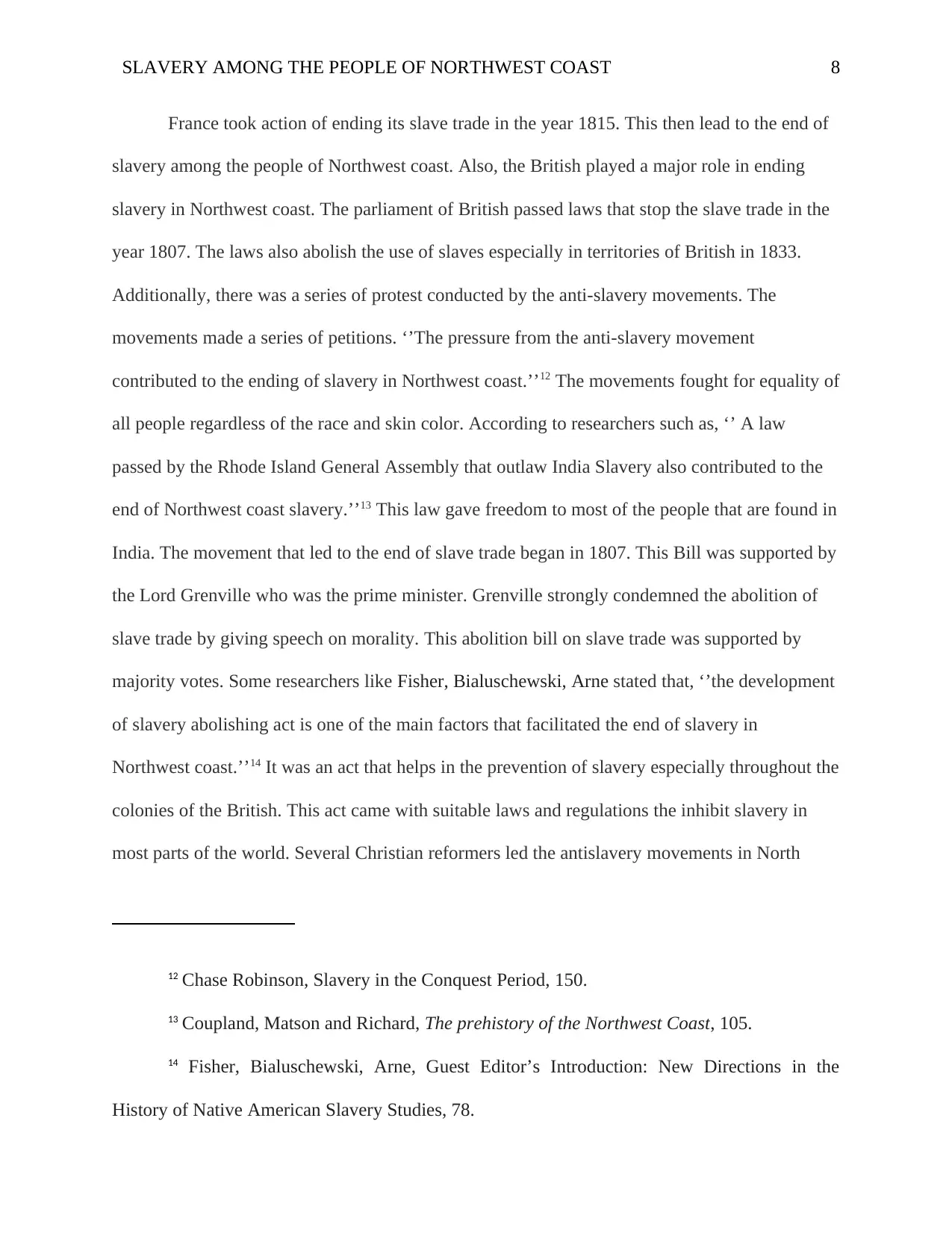
SLAVERY AMONG THE PEOPLE OF NORTHWEST COAST 8
France took action of ending its slave trade in the year 1815. This then lead to the end of
slavery among the people of Northwest coast. Also, the British played a major role in ending
slavery in Northwest coast. The parliament of British passed laws that stop the slave trade in the
year 1807. The laws also abolish the use of slaves especially in territories of British in 1833.
Additionally, there was a series of protest conducted by the anti-slavery movements. The
movements made a series of petitions. ‘’The pressure from the anti-slavery movement
contributed to the ending of slavery in Northwest coast.’’12 The movements fought for equality of
all people regardless of the race and skin color. According to researchers such as, ‘’ A law
passed by the Rhode Island General Assembly that outlaw India Slavery also contributed to the
end of Northwest coast slavery.’’13 This law gave freedom to most of the people that are found in
India. The movement that led to the end of slave trade began in 1807. This Bill was supported by
the Lord Grenville who was the prime minister. Grenville strongly condemned the abolition of
slave trade by giving speech on morality. This abolition bill on slave trade was supported by
majority votes. Some researchers like Fisher, Bialuschewski, Arne stated that, ‘’the development
of slavery abolishing act is one of the main factors that facilitated the end of slavery in
Northwest coast.’’14 It was an act that helps in the prevention of slavery especially throughout the
colonies of the British. This act came with suitable laws and regulations the inhibit slavery in
most parts of the world. Several Christian reformers led the antislavery movements in North
12 Chase Robinson, Slavery in the Conquest Period, 150.
13 Coupland, Matson and Richard, The prehistory of the Northwest Coast, 105.
14 Fisher, Bialuschewski, Arne, Guest Editor’s Introduction: New Directions in the
History of Native American Slavery Studies, 78.
France took action of ending its slave trade in the year 1815. This then lead to the end of
slavery among the people of Northwest coast. Also, the British played a major role in ending
slavery in Northwest coast. The parliament of British passed laws that stop the slave trade in the
year 1807. The laws also abolish the use of slaves especially in territories of British in 1833.
Additionally, there was a series of protest conducted by the anti-slavery movements. The
movements made a series of petitions. ‘’The pressure from the anti-slavery movement
contributed to the ending of slavery in Northwest coast.’’12 The movements fought for equality of
all people regardless of the race and skin color. According to researchers such as, ‘’ A law
passed by the Rhode Island General Assembly that outlaw India Slavery also contributed to the
end of Northwest coast slavery.’’13 This law gave freedom to most of the people that are found in
India. The movement that led to the end of slave trade began in 1807. This Bill was supported by
the Lord Grenville who was the prime minister. Grenville strongly condemned the abolition of
slave trade by giving speech on morality. This abolition bill on slave trade was supported by
majority votes. Some researchers like Fisher, Bialuschewski, Arne stated that, ‘’the development
of slavery abolishing act is one of the main factors that facilitated the end of slavery in
Northwest coast.’’14 It was an act that helps in the prevention of slavery especially throughout the
colonies of the British. This act came with suitable laws and regulations the inhibit slavery in
most parts of the world. Several Christian reformers led the antislavery movements in North
12 Chase Robinson, Slavery in the Conquest Period, 150.
13 Coupland, Matson and Richard, The prehistory of the Northwest Coast, 105.
14 Fisher, Bialuschewski, Arne, Guest Editor’s Introduction: New Directions in the
History of Native American Slavery Studies, 78.
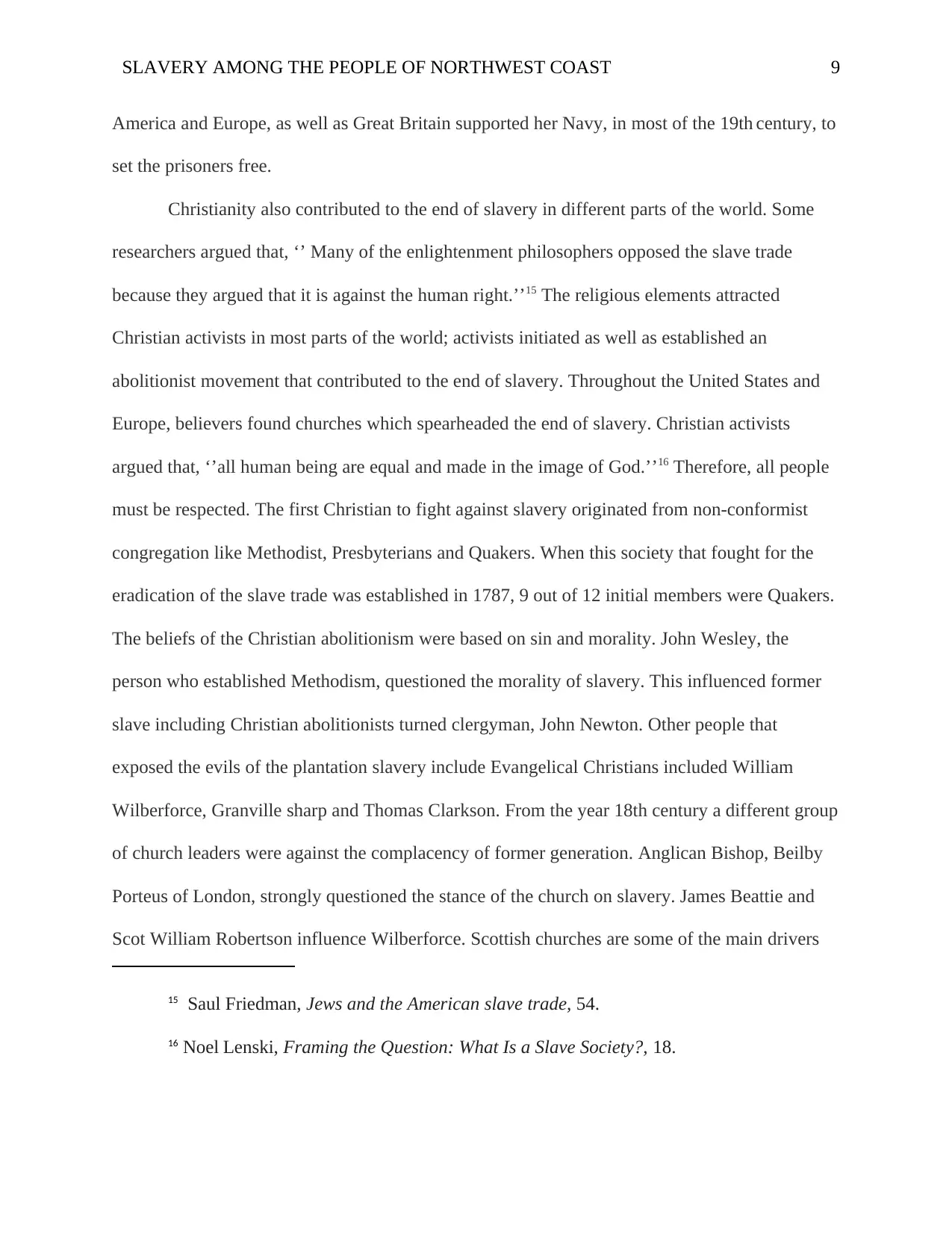
SLAVERY AMONG THE PEOPLE OF NORTHWEST COAST 9
America and Europe, as well as Great Britain supported her Navy, in most of the 19th century, to
set the prisoners free.
Christianity also contributed to the end of slavery in different parts of the world. Some
researchers argued that, ‘’ Many of the enlightenment philosophers opposed the slave trade
because they argued that it is against the human right.’’15 The religious elements attracted
Christian activists in most parts of the world; activists initiated as well as established an
abolitionist movement that contributed to the end of slavery. Throughout the United States and
Europe, believers found churches which spearheaded the end of slavery. Christian activists
argued that, ‘’all human being are equal and made in the image of God.’’16 Therefore, all people
must be respected. The first Christian to fight against slavery originated from non-conformist
congregation like Methodist, Presbyterians and Quakers. When this society that fought for the
eradication of the slave trade was established in 1787, 9 out of 12 initial members were Quakers.
The beliefs of the Christian abolitionism were based on sin and morality. John Wesley, the
person who established Methodism, questioned the morality of slavery. This influenced former
slave including Christian abolitionists turned clergyman, John Newton. Other people that
exposed the evils of the plantation slavery include Evangelical Christians included William
Wilberforce, Granville sharp and Thomas Clarkson. From the year 18th century a different group
of church leaders were against the complacency of former generation. Anglican Bishop, Beilby
Porteus of London, strongly questioned the stance of the church on slavery. James Beattie and
Scot William Robertson influence Wilberforce. Scottish churches are some of the main drivers
15 Saul Friedman, Jews and the American slave trade, 54.
16 Noel Lenski, Framing the Question: What Is a Slave Society?, 18.
America and Europe, as well as Great Britain supported her Navy, in most of the 19th century, to
set the prisoners free.
Christianity also contributed to the end of slavery in different parts of the world. Some
researchers argued that, ‘’ Many of the enlightenment philosophers opposed the slave trade
because they argued that it is against the human right.’’15 The religious elements attracted
Christian activists in most parts of the world; activists initiated as well as established an
abolitionist movement that contributed to the end of slavery. Throughout the United States and
Europe, believers found churches which spearheaded the end of slavery. Christian activists
argued that, ‘’all human being are equal and made in the image of God.’’16 Therefore, all people
must be respected. The first Christian to fight against slavery originated from non-conformist
congregation like Methodist, Presbyterians and Quakers. When this society that fought for the
eradication of the slave trade was established in 1787, 9 out of 12 initial members were Quakers.
The beliefs of the Christian abolitionism were based on sin and morality. John Wesley, the
person who established Methodism, questioned the morality of slavery. This influenced former
slave including Christian abolitionists turned clergyman, John Newton. Other people that
exposed the evils of the plantation slavery include Evangelical Christians included William
Wilberforce, Granville sharp and Thomas Clarkson. From the year 18th century a different group
of church leaders were against the complacency of former generation. Anglican Bishop, Beilby
Porteus of London, strongly questioned the stance of the church on slavery. James Beattie and
Scot William Robertson influence Wilberforce. Scottish churches are some of the main drivers
15 Saul Friedman, Jews and the American slave trade, 54.
16 Noel Lenski, Framing the Question: What Is a Slave Society?, 18.
⊘ This is a preview!⊘
Do you want full access?
Subscribe today to unlock all pages.

Trusted by 1+ million students worldwide
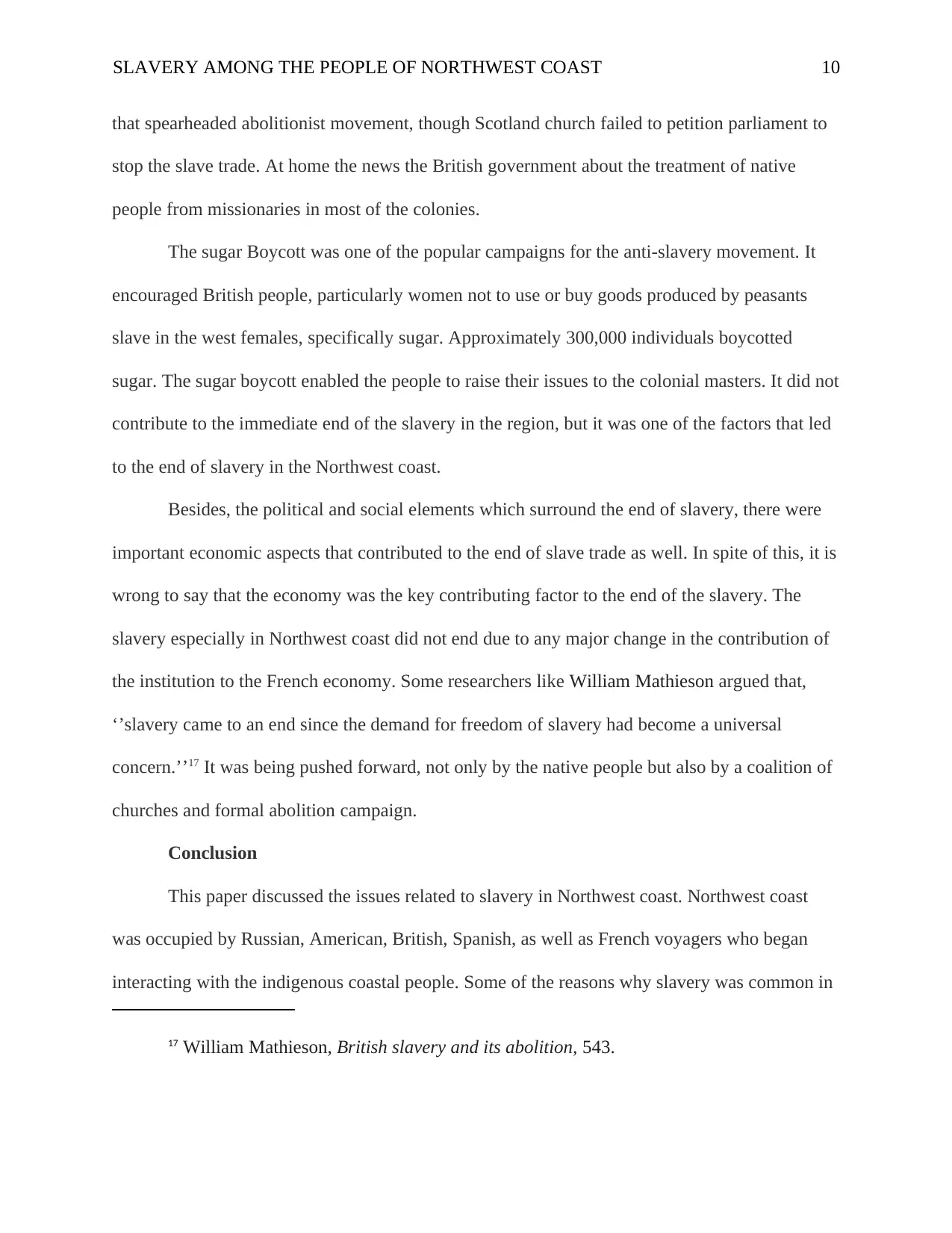
SLAVERY AMONG THE PEOPLE OF NORTHWEST COAST 10
that spearheaded abolitionist movement, though Scotland church failed to petition parliament to
stop the slave trade. At home the news the British government about the treatment of native
people from missionaries in most of the colonies.
The sugar Boycott was one of the popular campaigns for the anti-slavery movement. It
encouraged British people, particularly women not to use or buy goods produced by peasants
slave in the west females, specifically sugar. Approximately 300,000 individuals boycotted
sugar. The sugar boycott enabled the people to raise their issues to the colonial masters. It did not
contribute to the immediate end of the slavery in the region, but it was one of the factors that led
to the end of slavery in the Northwest coast.
Besides, the political and social elements which surround the end of slavery, there were
important economic aspects that contributed to the end of slave trade as well. In spite of this, it is
wrong to say that the economy was the key contributing factor to the end of the slavery. The
slavery especially in Northwest coast did not end due to any major change in the contribution of
the institution to the French economy. Some researchers like William Mathieson argued that,
‘’slavery came to an end since the demand for freedom of slavery had become a universal
concern.’’17 It was being pushed forward, not only by the native people but also by a coalition of
churches and formal abolition campaign.
Conclusion
This paper discussed the issues related to slavery in Northwest coast. Northwest coast
was occupied by Russian, American, British, Spanish, as well as French voyagers who began
interacting with the indigenous coastal people. Some of the reasons why slavery was common in
17 William Mathieson, British slavery and its abolition, 543.
that spearheaded abolitionist movement, though Scotland church failed to petition parliament to
stop the slave trade. At home the news the British government about the treatment of native
people from missionaries in most of the colonies.
The sugar Boycott was one of the popular campaigns for the anti-slavery movement. It
encouraged British people, particularly women not to use or buy goods produced by peasants
slave in the west females, specifically sugar. Approximately 300,000 individuals boycotted
sugar. The sugar boycott enabled the people to raise their issues to the colonial masters. It did not
contribute to the immediate end of the slavery in the region, but it was one of the factors that led
to the end of slavery in the Northwest coast.
Besides, the political and social elements which surround the end of slavery, there were
important economic aspects that contributed to the end of slave trade as well. In spite of this, it is
wrong to say that the economy was the key contributing factor to the end of the slavery. The
slavery especially in Northwest coast did not end due to any major change in the contribution of
the institution to the French economy. Some researchers like William Mathieson argued that,
‘’slavery came to an end since the demand for freedom of slavery had become a universal
concern.’’17 It was being pushed forward, not only by the native people but also by a coalition of
churches and formal abolition campaign.
Conclusion
This paper discussed the issues related to slavery in Northwest coast. Northwest coast
was occupied by Russian, American, British, Spanish, as well as French voyagers who began
interacting with the indigenous coastal people. Some of the reasons why slavery was common in
17 William Mathieson, British slavery and its abolition, 543.
Paraphrase This Document
Need a fresh take? Get an instant paraphrase of this document with our AI Paraphraser
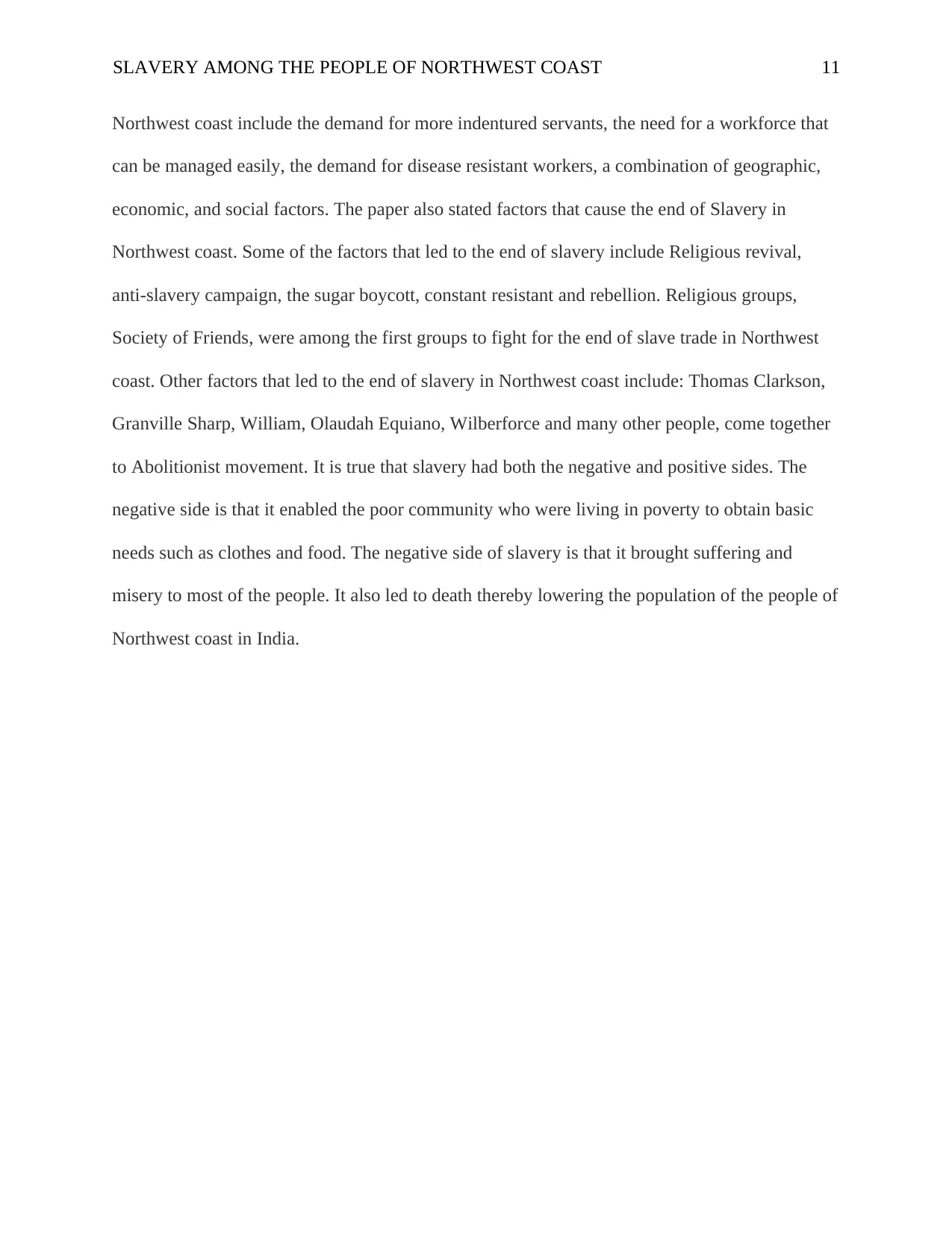
SLAVERY AMONG THE PEOPLE OF NORTHWEST COAST 11
Northwest coast include the demand for more indentured servants, the need for a workforce that
can be managed easily, the demand for disease resistant workers, a combination of geographic,
economic, and social factors. The paper also stated factors that cause the end of Slavery in
Northwest coast. Some of the factors that led to the end of slavery include Religious revival,
anti-slavery campaign, the sugar boycott, constant resistant and rebellion. Religious groups,
Society of Friends, were among the first groups to fight for the end of slave trade in Northwest
coast. Other factors that led to the end of slavery in Northwest coast include: Thomas Clarkson,
Granville Sharp, William, Olaudah Equiano, Wilberforce and many other people, come together
to Abolitionist movement. It is true that slavery had both the negative and positive sides. The
negative side is that it enabled the poor community who were living in poverty to obtain basic
needs such as clothes and food. The negative side of slavery is that it brought suffering and
misery to most of the people. It also led to death thereby lowering the population of the people of
Northwest coast in India.
Northwest coast include the demand for more indentured servants, the need for a workforce that
can be managed easily, the demand for disease resistant workers, a combination of geographic,
economic, and social factors. The paper also stated factors that cause the end of Slavery in
Northwest coast. Some of the factors that led to the end of slavery include Religious revival,
anti-slavery campaign, the sugar boycott, constant resistant and rebellion. Religious groups,
Society of Friends, were among the first groups to fight for the end of slave trade in Northwest
coast. Other factors that led to the end of slavery in Northwest coast include: Thomas Clarkson,
Granville Sharp, William, Olaudah Equiano, Wilberforce and many other people, come together
to Abolitionist movement. It is true that slavery had both the negative and positive sides. The
negative side is that it enabled the poor community who were living in poverty to obtain basic
needs such as clothes and food. The negative side of slavery is that it brought suffering and
misery to most of the people. It also led to death thereby lowering the population of the people of
Northwest coast in India.
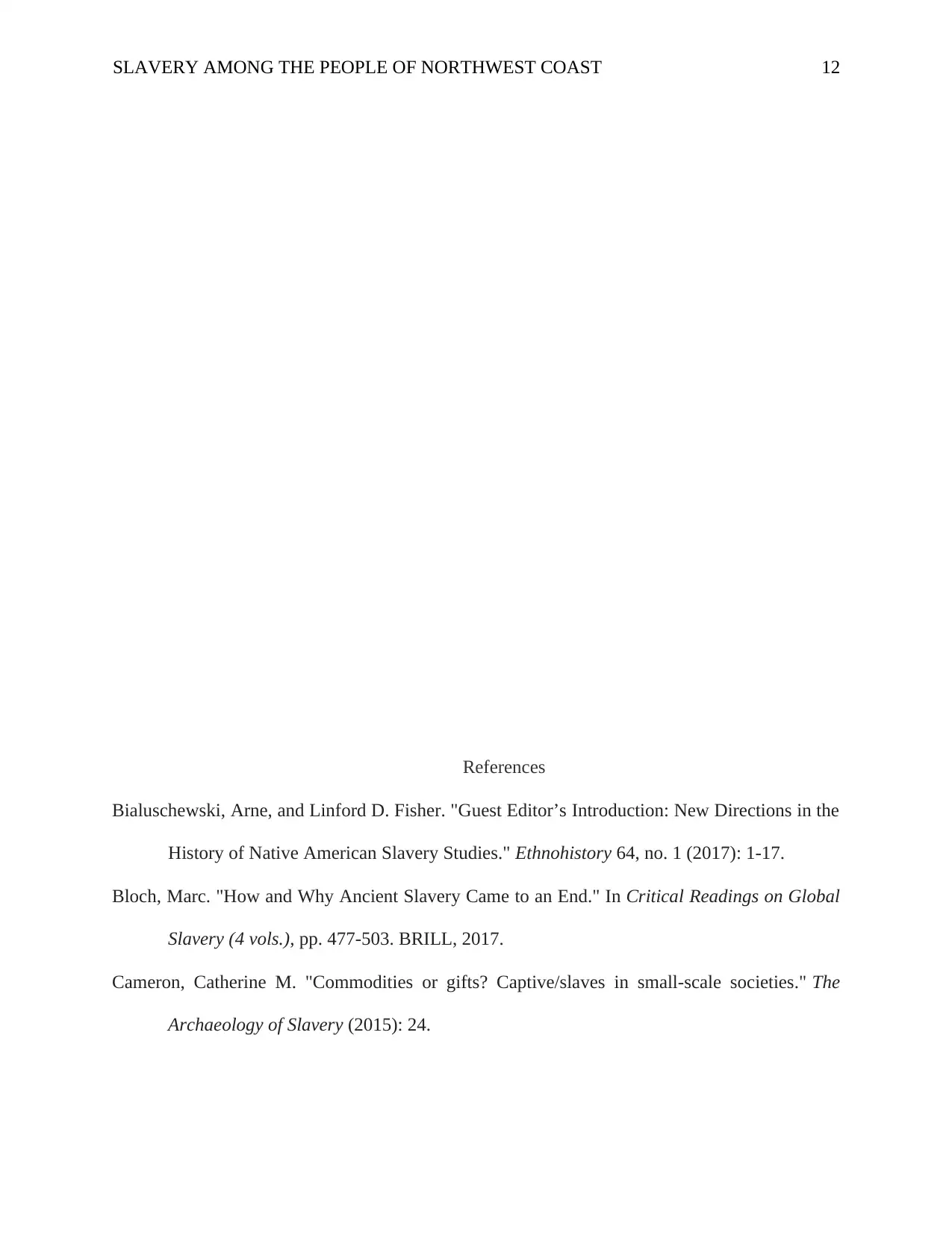
SLAVERY AMONG THE PEOPLE OF NORTHWEST COAST 12
References
Bialuschewski, Arne, and Linford D. Fisher. "Guest Editor’s Introduction: New Directions in the
History of Native American Slavery Studies." Ethnohistory 64, no. 1 (2017): 1-17.
Bloch, Marc. "How and Why Ancient Slavery Came to an End." In Critical Readings on Global
Slavery (4 vols.), pp. 477-503. BRILL, 2017.
Cameron, Catherine M. "Commodities or gifts? Captive/slaves in small-scale societies." The
Archaeology of Slavery (2015): 24.
References
Bialuschewski, Arne, and Linford D. Fisher. "Guest Editor’s Introduction: New Directions in the
History of Native American Slavery Studies." Ethnohistory 64, no. 1 (2017): 1-17.
Bloch, Marc. "How and Why Ancient Slavery Came to an End." In Critical Readings on Global
Slavery (4 vols.), pp. 477-503. BRILL, 2017.
Cameron, Catherine M. "Commodities or gifts? Captive/slaves in small-scale societies." The
Archaeology of Slavery (2015): 24.
⊘ This is a preview!⊘
Do you want full access?
Subscribe today to unlock all pages.

Trusted by 1+ million students worldwide
1 out of 14
Your All-in-One AI-Powered Toolkit for Academic Success.
+13062052269
info@desklib.com
Available 24*7 on WhatsApp / Email
![[object Object]](/_next/static/media/star-bottom.7253800d.svg)
Unlock your academic potential
Copyright © 2020–2025 A2Z Services. All Rights Reserved. Developed and managed by ZUCOL.


